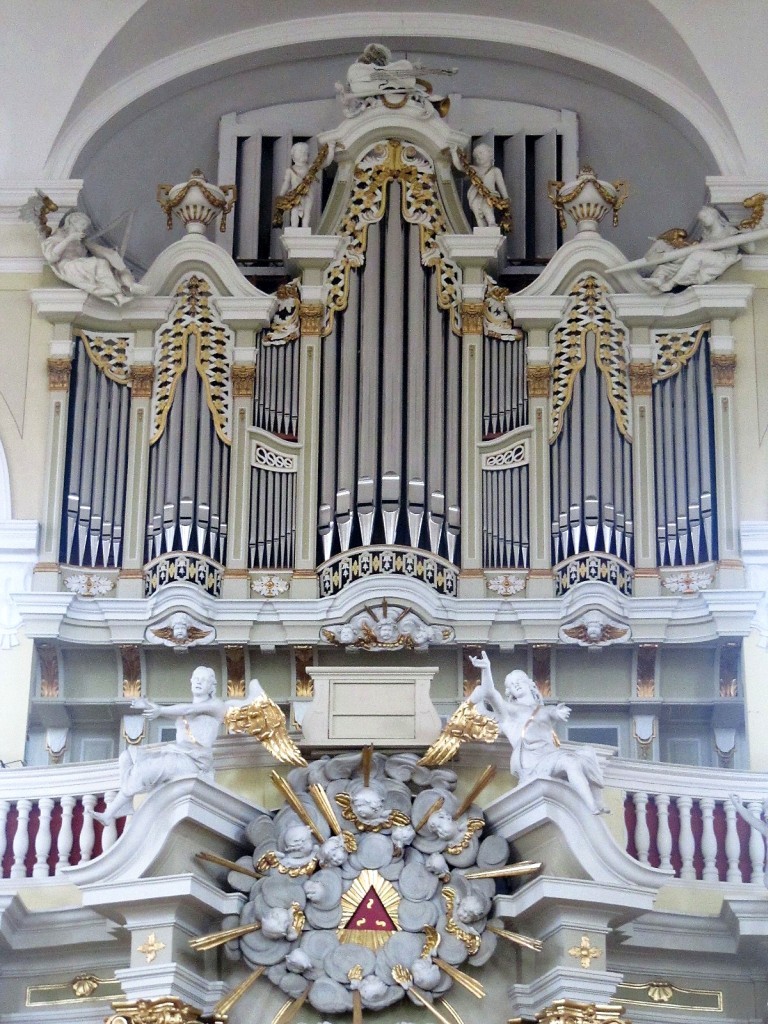Complete description of the selected organ

Photo: Wolfgang Reich
Großenhain, Deutschland (Sachsen) - Marienkirche
Municipal: Großenhain
Address: Kirchplatz 2, 01558, Großenhain
Website: http://www.marienkirche-grossenhain.de/
https://www.kirchspiel-grossenhain.de/
Description nr.: 2014716.
Built by: Jehmlich Orgelbau (1901)
The organ contains older material: Organ case from 1778 by Johann Gottlieb Mauer
Technical data
Specification
I. Manual (C-a'''): Prinzipal 16', Gedackt 16', Prinzipal 8', Bordun 8', Salicional 8', Oktave 4', Hohlflöte 4', Quinte 2 2/3' - 1940, Oktave 2', Nachthorn 2' - 1940, Cornett 4-5 fach, Rauschwerk 4-5 fach (16') - 1901/1962, Mixtur 4-5 fach - 1962/2001, Trompete 8'.
II. Manual (C-a'''): Quintatön 16' - 1962, Prinzipal 8', Gedackt 8', Quintatön 8', Oktave 4', Rohrflöte 4', Salicet 4', Oktave 2', Flachflöte 2' - 1962, Quinte 1 1/3' - 1962, Sifflet 1' - 1962, Terzianscharf 4 fach - 1962/2001, Krummhorn 8' - 1962, Regal 4' - 1901/1962.
III. Manual (in zwelkast) (C-a'''): Gedackt 16', Rohrflöte 8', Gemshorn 8', Dulciana 8' - 1962, Prinzipal 4', Holzflöte 4' - 1962, Nasat 2 2/3' - 1940, Spitzgambe 2' - 1962, Querflöte 2' - 1962, Blockflötenterz 1 1/3' - 1940, Schwiegel 1' - 1962, Quintzimbel 3-4 fach - 1962/2001, Oboe 8', Tremolant.
Pedal (C-f'): Prinzipal 16', Subbaß 16', Gedacktbaß 16', Quintbaß 10 2/3', Oktavbaß 8', Gedacktflöte 8' - 1962, Oktavbaß 4', Prinzipalflöte 2' - 1962, Hintersatz 6 fach - 1962, Posaune 16', Trompete 8', Clarine 4'.
Couplers: I. Manual - II. Manual, I. Manual - III. Manual, II. Manual - III. Manual, Pedal - I. Manual, Pedal - II. Manual, Pedal - III. Manual.
Accessories: 2 freie Vorbereitungen, Rohrwerke ab, Handregister ab.
Other sources

Photo: Wolfgang Reich
Großenhain, Deutschland (Sachsen) - Marienkirche
Municipal: Großenhain
Address: Kirchplatz 2, 01558, Großenhain
Website: http://www.marienkirche-grossenhain.de/
https://www.kirchspiel-grossenhain.de/
Description nr.: 2014716.
Built by: Jehmlich Orgelbau (1901)
The organ contains older material: Organ case from 1778 by Johann Gottlieb Mauer
| Year | Builder | Opus | Activity | 1684 | Builder unknown | new organ | 1748 | Johann Heinrich Gräbner | new organ | 1778 | Johann Gottlieb Mauer | new organ | 1880 | Gebrüder Nagel | modify stoplist | 1901 | Jehmlich Orgelbau | new organ in old case | 1940 | Jehmlich Orgelbau | restoration and enlargement | 1962 | Jehmlich Orgelbau | modify stoplist | 2001 | Groß & Soldan | restoration |
- The Marienkirche in Großenhain had an organ since 1506. In the seventeenth century there were two organs in the church. In 1682-1684 a new main organ was built with 26 stops. When the church burned down in 1744, this instrument was lost. The church building was rebuilt after the fire. On December 15, 1748, the building could be rededicated. Johann Georg Schmidt designed an altar with an organ prospect above it. Johann Ernst Hähnel was commisioned to build the organ, but eventually this order was canceled. An organ was temporarily delivered in 1748 by J.G. Gräbner, which remained in use until 1778.
- In that year a new organ was put into use, built by Johann Gottlieb Maurer from Leipzig. The organ had two manuals and an independent pedal with a total number of 30 stops. The organ was inaugurated on December 13, 1778, the third Sunday of Advent. The organist on this occasion was Johann Gottlieb Hennersdorf. The organ was well maintained throughout the nineteenth century.
- The first modifications were not made until 1880. The company Gebr. Nagel replaced the Trompete of the Hauptwerk with a Rohrflöte 8' and the Vox Humana of the Oberwerk with a Gamba 8'. They also renewed the bellows. In 1901, however, the organ was removed except for the organ case. The Jehmlich company built a new organ in romantic style behind the historic prospect.
- In 1917 the front pipes were requisitioned. In 1924 they were replaced by new pipes made of zinc. On the advice of cantor organist Herbert Gadsch, the organ was modified in 1940 by the company Jehmlich. They expanded the first manual with a Quinte 2 2/3', Nachthorn 2' and a Terz 1 3/5', the second manual with a Superquinte 1 1/3' and a Sifflöte 1' and the third manual with a Nasat 2 2/3', a Blockflötenterz 1 1/3' and a Tremolant. A Prinzipal 2' was placed on the pedal and finally the Aeoline was moved from manual II to manual III.
- The modifications of 1962 were more drastic. In that year, the Jehmlich company carried out a major cleaning, but several stops were replaced or altered. The Clarinet of manual II has been moved to a Regal 4'. The Mixtur 4-5 fach from manual I was adapted to a Rauschwerk 4-5 fach. The purpose was to give the organ a more baroque character. A large part of the pipes were revoiced by Jehmlich.
- On the advice of cantor organist Joachim Jänke, preparations started in 1994 for a restoration of the organ. It was decided to maintain the existing situation. But the instrument had to be re-voiced, and some mixtures would also be altered. The front pipes from 1924 have been replaced by new tin ones. The company Groß & Soldan was commissioned, and the work was carried out in 2001. On August 18, 2001 the organ was put back into use with a recital by Joachim Jänke.
Technical data
| Number of stops per division | |
| - I. Manual | 14 |
| - II. Manual | 14 |
| - III. Manual | 13 |
| - Pedal | 12 |
| Total number of stops | 53 |
| Key action | Pneumatic |
| Stop action | Pneumatic |
| Windchest(s) | Cone chests |
Specification
I. Manual (C-a'''): Prinzipal 16', Gedackt 16', Prinzipal 8', Bordun 8', Salicional 8', Oktave 4', Hohlflöte 4', Quinte 2 2/3' - 1940, Oktave 2', Nachthorn 2' - 1940, Cornett 4-5 fach, Rauschwerk 4-5 fach (16') - 1901/1962, Mixtur 4-5 fach - 1962/2001, Trompete 8'.
II. Manual (C-a'''): Quintatön 16' - 1962, Prinzipal 8', Gedackt 8', Quintatön 8', Oktave 4', Rohrflöte 4', Salicet 4', Oktave 2', Flachflöte 2' - 1962, Quinte 1 1/3' - 1962, Sifflet 1' - 1962, Terzianscharf 4 fach - 1962/2001, Krummhorn 8' - 1962, Regal 4' - 1901/1962.
III. Manual (in zwelkast) (C-a'''): Gedackt 16', Rohrflöte 8', Gemshorn 8', Dulciana 8' - 1962, Prinzipal 4', Holzflöte 4' - 1962, Nasat 2 2/3' - 1940, Spitzgambe 2' - 1962, Querflöte 2' - 1962, Blockflötenterz 1 1/3' - 1940, Schwiegel 1' - 1962, Quintzimbel 3-4 fach - 1962/2001, Oboe 8', Tremolant.
Pedal (C-f'): Prinzipal 16', Subbaß 16', Gedacktbaß 16', Quintbaß 10 2/3', Oktavbaß 8', Gedacktflöte 8' - 1962, Oktavbaß 4', Prinzipalflöte 2' - 1962, Hintersatz 6 fach - 1962, Posaune 16', Trompete 8', Clarine 4'.
Couplers: I. Manual - II. Manual, I. Manual - III. Manual, II. Manual - III. Manual, Pedal - I. Manual, Pedal - II. Manual, Pedal - III. Manual.
Accessories: 2 freie Vorbereitungen, Rohrwerke ab, Handregister ab.
| Other specifications | |
|---|---|
| Different specifications |
|
| Literature |
|
- Joep van Koert
 |
 |
 |
 |
 |
